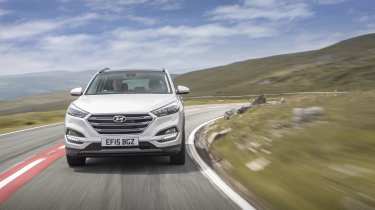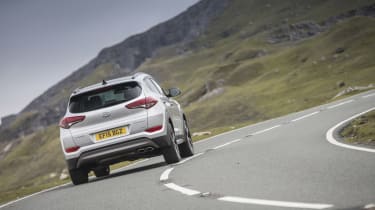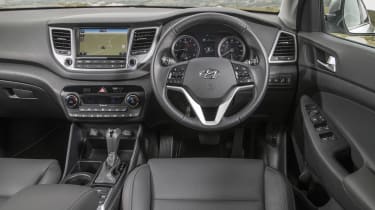Hyundai Tucson review - can it entertain like a Skoda Yeti?
Hyundai's latest compact crossover is a fine car, but won't offer the fun of a Skoda Yeti on twisting roads
What is it?
Hyundai’s latest entrant into the crossover market, and the resurrection of the Tucson name – the previous car was dubbed ix35.
While not an evo car on the surface, Skoda’s Yeti showed us that you need not sacrifice polished driving dynamics and or even fun once you’ve resigned yourself to a practical family wagon, and the reduced weight of cars in this class, thanks to high-strength steels and downsized, turbocharged powerplants, opens up greater potential for driving involvement.
Performance and 0-60mph time
Hyundai has expanded the choice of engines for this generation, offering naturally-aspirated and turbocharged 1.6-litre petrols, and a choice of 1.7-litre and 2.0-litre diesels.
The basic 1.6 and the 1.7 diesel are carried over from the previous car largely unchanged, but the new engines certainly expand the car’s appeal. The petrol in particular is of interest, carried over from the Hyundai i30 Turbo and available in higher-output form in the Kia Proceed GT.
It produces 175bhp, and has a 195lb ft torque spread between 1500-4500rpm, with either a six-speed manual or seven-speed dual-clutch transmission available. Both come with standard all-wheel drive. The DCT shaves four tenths from the manual’s 9.5sec 0-62mph run, and goes half a mile further on every gallon of fuel, at 37.7mpg combined.
More reviews
Group tests
- Lotus Emira Turbo SE v Alpine A110 GTS – two of the last surviving mid-engined sports cars
- Alpine A290 v Alpine A110 – how much DNA do they really share?
- Ariel Atom 4R v Caterham Seven ‘evo25’: power-to-weight heroes go head-to-head
- Ariel Atom 4 v Caterham Seven 310R v Lotus Elise Cup 250
- £200,000 supercar shoot-out: AMG v Aston Martin v Maserati v McLaren
- Audi Quattro, RS2 and RS3: five-cylinder icons head-to-head
- Who makes the best GT car? Aston Martin v Bentley v Maserati
- Caterham Super Seven 600 v Super Seven 2000
- Corvette Stingray v Porsche Cayman GTS v Audi R8 RWD
- GMA T.50 v McLaren F1 – has the best car in the world been dethroned by its successor?
In-depth reviews
- Abarth 600e 2025 review – Italy gives the Alpine A290 something to worry about
- Alpine A110 review – the sports car Lotus should be building
- Aston Martin Vantage 2025 review – a thrilling Mercedes-AMG GT and 911 Turbo S alternative
- Audi R8 (2015 - 2024) review – the ultimate soft-focus supercar
- Bentley Flying Spur review – the ultimate driver’s limousine
Long term tests
- Abarth 695C Turismo Fast Fleet test – living with the charming Italian hatch
- Alfa Romeo Giulia Veloce long term test – can Italy beat Germany?
- Alpina B10: Alpina B10: end of term report
- Aston Martin Vantage (2006) Fast Fleet test – living with a £30k V8 Aston
- Caterham Seven evo25 Fast Fleet test – living with a track car for the road
- Caterham Seven evo Edition revealed – bespoke 420R joins the Fast Fleet
- Cupra Leon 300 Fast Fleet test – living with Spain's 300bhp hot hatch
- Cupra Ateca VZN Fast Fleet test – four months with Cupra's hot crossover
- Cupra Leon Estate 310 4Drive Fast Fleet test – living with the 306bhp hot estate
- Ford Mustang GT
Review
- New Bentley Batur 2023 review – can it possibly be worth £1.65m?
- 2023 Chevrolet Corvette C8 Z06 review – the American 911 GT3?
- BBR Supercharged Mazda MX-5 (ND) 2023 review – tuned 250bhp roadster driven
- MG4 Trophy 2023 review
Reviews
- Abarth 695 75 Anniversario edition 2024 review – a fitting send-off for Abarth’s hot supermini?
- Abarth 500e 2023 review
- AC Cobra 378 Superblower MkIV 2021 review – another V8 Cobra, but with a GM heart this time
- Acura Integra Type S 2024 review – a Honda Civic Type R with added restraint
- Alfa Romeo Giulia review – get one while you still can
- Alfa Romeo 33 Stradale 2025 review – a rare Italian jewel beyond compare
- Alfa Romeo SZ: history, review and specs of an icon
The diesels are the more frugal – the 1.7 achieves 61.7mpg combined with the lowest CO2 at 119gkm. The 2.0 manages up to 58.9mpg in manual, two-wheel drive form. It produces 134bhp in standard form, but a 182bhp version (with 295lb ft of torque) is also available, with a six-speed manual or six-speed torque converter automatic. The latter reaches 62mph in 9.5sec and turns in a 43.5mpg average fuel consumption figure.
Technical details
Hyundai tested the new Tucson on European roads, to closer align the car’s ride and handling characteristics to the tastes of European buyers. In addition to temperature testing, engineers assessed the car at high speed and even on the Nurburgring – clearly not exclusive to high-performance cars and hot hatchbacks.
The electrically-assisted steering box is now mounted on the rack, rather than the column, in the pursuit of better feel. Spring and damper rates have been tuned not just for better ride and handling, but lower NVH, which is also assisted by greatly increased use of high-strength steels in the bodyshell.
What’s it like to drive?
Better with the newly-introduced turbocharged petrol we tried, than with the 1.7 CRDi diesel Hyundai expects to be its biggest-seller. Where the diesel never quite motivates the car to pulse-raising pace, the petrol has all the appealing smoothness, keen mid-range and responsiveness we’ve come to expect from this generation of engines.
Provided you leave the optional dual-clutch transmission in Sport mode, at any rate. Early gearchanges in the normal mode, designed to fox official fuel economy tests, result in lethargic response and subdued progress. In Sport, the gearbox typically holds you in a lower gear, raising revs to the torque peak and punching harder away from lights or out of corners.
Sadly, the Tucson falls short of Yeti-style dynamics, but you can at least make flowing progress thanks to a supple ride and direct steering. There’s only a hint of feel through the rim despite the revised assistance setup, and we’d like a bit more weight too – load doesn’t really build through corners, which can be disconcerting as you up the pace.
It’s hard to criticise the car for this given its intended market, and the light, easy clutch and gearlever in the manual-equipped diesel is equally appropriate for the car’s target audience. It’s just a shame the dynamic quality found in premium crossovers hasn’t yet permeated their equivalents in the value sector.
Rivals
Closest in many respects is the Sportage, from Hyundai’s subsidiary Kia. There’s a new model on the way offering the same features as the Hyundai, and Kia’s 7-year warranty make it an appealing prospect to those prioritising value. For absolute value, the Dacia Duster is worth a look – though it’s an agricultural beast by the standards of modern crossovers.
And then there’s the Skoda Yeti. We were so impressed by Skoda’s crossover we once ran one in the evo Fast Fleet, and it remains one of the best options for buyers looking to mix practicality, value and fun in a family vehicle. The chunky styling has aged well, too.
Price
The Tucson range starts at £18,695 for an entry-level S model with the 1.6-litre petrol – that’s high-end supermini money these days, reaffirming Hyundai’s value-led market positioning. Kit levels are still high, with standard DAB, Bluetooth, 16-inch alloy wheels, air conditioning and automatic headlights.
SE models start at £20,495 and SE Nav at £21,295. Above that are Premium (£25,045) and Premium SE (£28,345). The latter grades are the only place you’ll find the turbocharged petrol.



